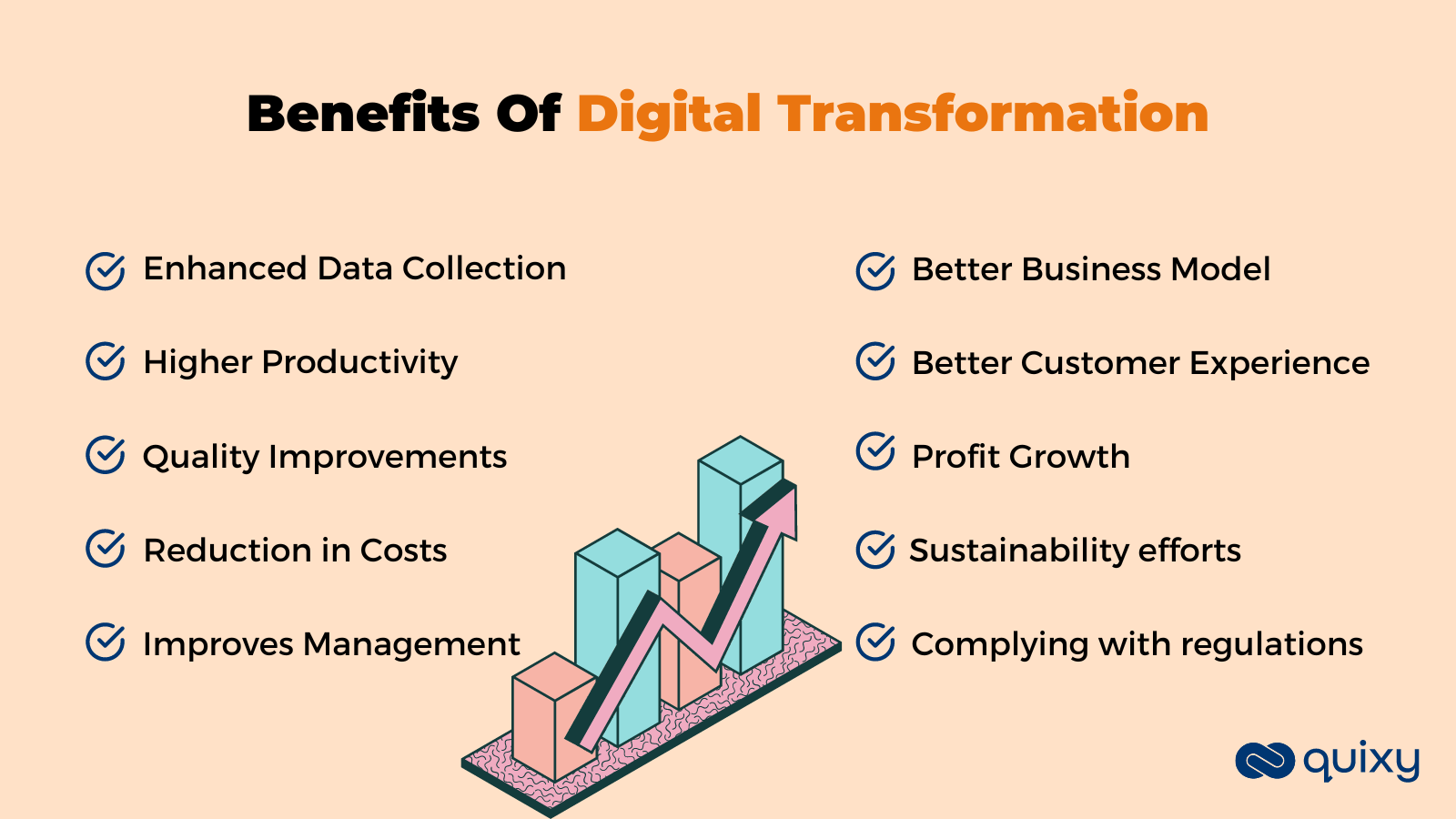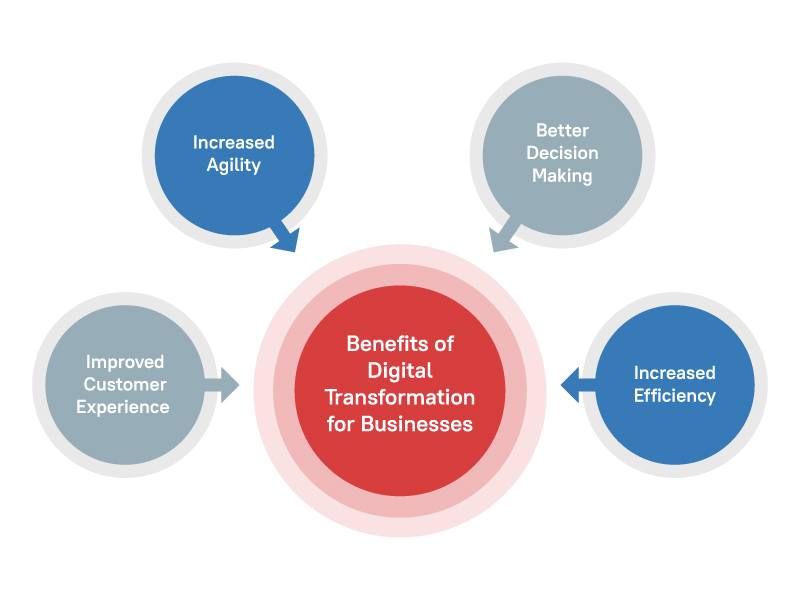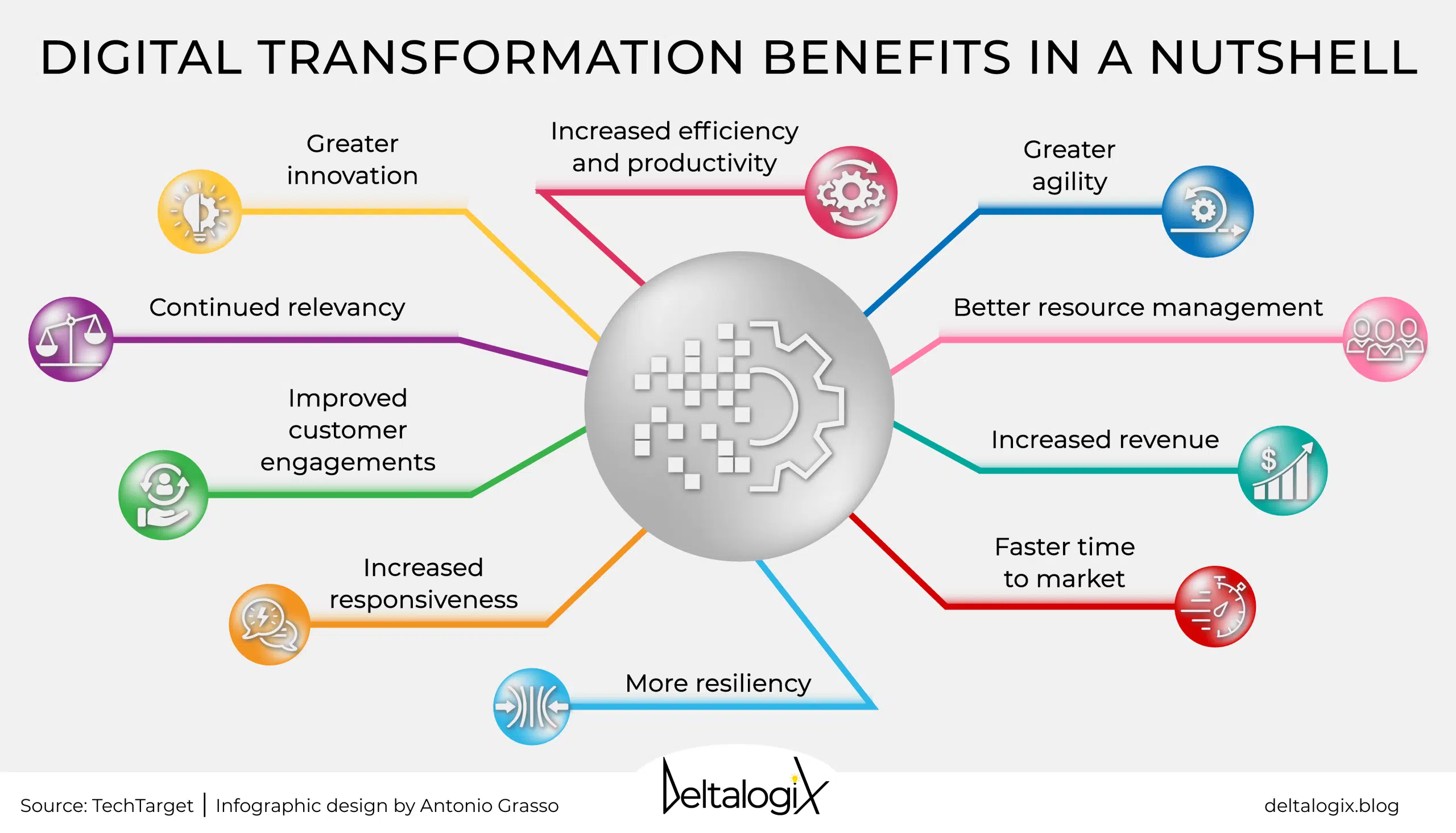Benefits of Digital Transformation
In today’s rapidly evolving business environment, digital transformation is not just a trend—it’s a fundamental shift in how companies operate, engage with customers, and achieve their goals. Businesses that embrace digital transformation stand to gain a significant competitive advantage, enhance their operations, and improve overall profitability. But what exactly are the benefits of digital transformation? In this article, we’ll explore how adopting digital technologies can improve efficiency, boost customer experience, and drive innovation.

What is Digital Transformation?
Digital transformation refers to the process of integrating digital technologies into all areas of business operations. It involves transforming business models, processes, and organizational culture to align with the demands of the digital age. This transformation is not just about adopting new technologies; it’s about reimagining how a business operates, communicates with customers, and delivers products or services.
Key Components of Digital Transformation
- Cloud computing for greater flexibility and scalability.
- Data analytics to drive informed decision-making.
- Artificial intelligence (AI) and machine learning to automate tasks and gain insights.
- Mobile technologies that enable employees and customers to engage anywhere.
- Automation tools that streamline operations and reduce manual tasks.
The Core Benefits of Digital Transformation
1. Improved Operational Efficiency
One of the most significant benefits of digital transformation is the improvement of operational efficiency. By integrating digital tools and systems into daily processes, businesses can:
- Automate repetitive tasks: Automating tasks like data entry, customer support, and inventory management can reduce the time spent on mundane activities, allowing employees to focus on more strategic initiatives.
- Streamline workflows: Digital tools like project management software and collaboration platforms help optimize workflows, improving communication and productivity across teams.
- Reduce errors and improve accuracy: Automation and real-time data updates help reduce human error, ensuring that processes are completed accurately and consistently.
2. Enhanced Customer Experience
In the digital era, customer expectations are at an all-time high. Customers demand personalized, seamless experiences across multiple channels. Digital transformation allows businesses to meet these expectations by:
- Personalizing interactions: By leveraging data analytics, companies can create tailored customer experiences, offering personalized products, services, and marketing efforts.
- 24/7 availability: Digital tools such as chatbots and AI-driven customer service platforms ensure that businesses can provide round-the-clock support, even outside normal working hours.
- Omnichannel experiences: Customers today expect consistency across platforms. Digital transformation enables companies to create a unified experience whether customers interact through websites, apps, or in-store.

3. Better Decision Making with Data Insights
Data is the new oil, and digital transformation enables businesses to harness the power of data. With the right tools in place, businesses can:
- Gain actionable insights: Data analytics allows companies to analyze vast amounts of data, providing insights that can guide business decisions, optimize operations, and improve customer experiences.
- Predict trends and behaviors: With tools like predictive analytics, companies can forecast future trends, customer behaviors, and market conditions, helping them stay ahead of the competition.
- Make informed decisions faster: Real-time data collection and analysis enable businesses to make quicker, more informed decisions, improving agility and responsiveness.
4. Fostering Innovation and Growth
Digital transformation opens up opportunities for companies to innovate and grow by leveraging cutting-edge technologies like AI, IoT, and blockchain. Here’s how it contributes to innovation:
- New business models: Digital tools enable businesses to explore new business models, such as subscription-based services, e-commerce platforms, and digital products that were previously unimaginable.
- Product and service innovation: With access to new technologies, businesses can develop innovative products or services that meet the evolving needs of their customers. For instance, the use of 3D printing or AI algorithms in product design can significantly improve the design and delivery of new solutions.
- Improved research and development: Digital tools like collaboration software and cloud storage make it easier for R&D teams to collaborate, share data, and create new innovations faster.
5. Cost Savings and Increased Profitability
Many businesses begin their digital transformation journey with the goal of reducing costs, and digital tools can help achieve this in various ways:
- Lower operational costs: Cloud computing, automation, and AI tools can replace costly hardware, reduce the need for manual labor, and streamline operations, resulting in lower operating costs.
- Optimized resource allocation: With better insights into business operations, companies can better allocate resources, ensuring that every dollar spent is contributing to their overall goals.
- Improved scalability: Digital tools allow businesses to scale operations without major investments in physical infrastructure, enabling businesses to grow without significantly increasing overhead costs.

6. Increased Agility and Flexibility
In today’s volatile business environment, agility is crucial. Digital transformation enables businesses to be more agile and responsive to changing market conditions by:
- Adapting to changes quickly: With cloud solutions and digital collaboration tools, companies can adapt their strategies, products, and services faster in response to market demands or external challenges.
- Remote work flexibility: The shift to remote work during the pandemic showed how digital tools can enable teams to stay productive and connected from anywhere, improving work-life balance and overall employee satisfaction.
- Real-time collaboration: Digital transformation enables teams to collaborate in real time, whether they are working in the same office or across different locations, increasing productivity and reducing delays in project timelines.
7. Improved Employee Experience
Digital transformation doesn’t only benefit customers—it also enhances the employee experience. Businesses can:
- Empower employees: With digital tools, employees have the resources they need to work more efficiently, make data-driven decisions, and communicate seamlessly.
- Support continuous learning: With access to online learning platforms, employees can continuously upskill and stay updated with the latest tools and technologies, boosting both individual and organizational performance.
- Foster a culture of innovation: Digital transformation often leads to a culture shift within organizations, encouraging employees to embrace change, experiment with new ideas, and contribute to the company’s growth.
8. Improved Security and Compliance
As cyber threats become more sophisticated, data security is a top priority for businesses. Digital transformation can enhance security and ensure compliance by:
- Adopting robust security protocols: Technologies like encryption, multi-factor authentication, and AI-driven threat detection help safeguard sensitive data and protect against cyberattacks.
- Automating compliance processes: Many businesses face strict regulatory requirements, and digital transformation can help automate compliance processes, ensuring that businesses remain compliant with laws and regulations.

Conclusion
The benefits of digital transformation are undeniable, and businesses that embrace it position themselves for long-term success. By adopting digital technologies, businesses can streamline operations, improve customer experiences, drive innovation, and achieve cost savings. However, digital transformation is not a one-time project—it’s an ongoing journey that requires continuous investment, adaptation, and a commitment to change.
FAQs about Digital Transformation
1. How do I start my digital transformation journey?
Start by assessing your current processes and identifying areas where digital tools can add value. Invest in technologies like cloud computing, data analytics, and AI that align with your business goals.
2. Is digital transformation expensive?
The cost of digital transformation varies depending on the size of the business and the technologies implemented. However, the long-term savings and benefits typically outweigh the initial investment.
3. Can small businesses benefit from digital transformation?
Absolutely! Digital transformation is not just for large enterprises—small businesses can also leverage digital tools to enhance customer experiences, optimize operations, and grow their businesses.
4. How long does digital transformation take?
The timeline for digital transformation varies based on the complexity of the changes and the size of the organization. It can take several months to years, but the process should be continuous.
By understanding the benefits of digital transformation, businesses can adapt and thrive in an increasingly digital world. The journey may be challenging, but the rewards are worth it.
